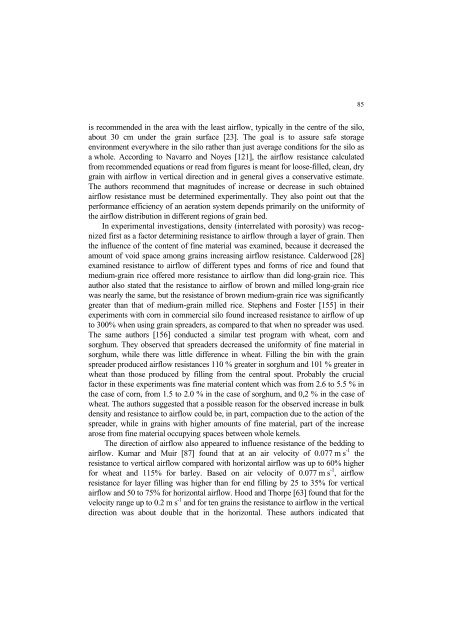Strona 2_redak - Instytut Agrofizyki im. Bohdana DobrzaÅskiego ...
Strona 2_redak - Instytut Agrofizyki im. Bohdana DobrzaÅskiego ...
Strona 2_redak - Instytut Agrofizyki im. Bohdana DobrzaÅskiego ...
You also want an ePaper? Increase the reach of your titles
YUMPU automatically turns print PDFs into web optimized ePapers that Google loves.
85<br />
is recommended in the area with the least airflow, typically in the centre of the silo,<br />
about 30 cm under the grain surface [23]. The goal is to assure safe storage<br />
environment everywhere in the silo rather than just average conditions for the silo as<br />
a whole. According to Navarro and Noyes [121], the airflow resistance calculated<br />
from recommended equations or read from figures is meant for loose-filled, clean, dry<br />
grain with airflow in vertical direction and in general gives a conservative est<strong>im</strong>ate.<br />
The authors recommend that magnitudes of increase or decrease in such obtained<br />
airflow resistance must be determined exper<strong>im</strong>entally. They also point out that the<br />
performance efficiency of an aeration system depends pr<strong>im</strong>arily on the uniformity of<br />
the airflow distribution in different regions of grain bed.<br />
In exper<strong>im</strong>ental investigations, density (interrelated with porosity) was recognized<br />
first as a factor determining resistance to airflow through a layer of grain. Then<br />
the influence of the content of fine material was examined, because it decreased the<br />
amount of void space among grains increasing airflow resistance. Calderwood [28]<br />
examined resistance to airflow of different types and forms of rice and found that<br />
medium-grain rice offered more resistance to airflow than did long-grain rice. This<br />
author also stated that the resistance to airflow of brown and milled long-grain rice<br />
was nearly the same, but the resistance of brown medium-grain rice was significantly<br />
greater than that of medium-grain milled rice. Stephens and Foster [155] in their<br />
exper<strong>im</strong>ents with corn in commercial silo found increased resistance to airflow of up<br />
to 300% when using grain spreaders, as compared to that when no spreader was used.<br />
The same authors [156] conducted a s<strong>im</strong>ilar test program with wheat, corn and<br />
sorghum. They observed that spreaders decreased the uniformity of fine material in<br />
sorghum, while there was little difference in wheat. Filling the bin with the grain<br />
spreader produced airflow resistances 110 % greater in sorghum and 101 % greater in<br />
wheat than those produced by filling from the central spout. Probably the crucial<br />
factor in these exper<strong>im</strong>ents was fine material content which was from 2.6 to 5.5 % in<br />
the case of corn, from 1.5 to 2.0 % in the case of sorghum, and 0,2 % in the case of<br />
wheat. The authors suggested that a possible reason for the observed increase in bulk<br />
density and resistance to airflow could be, in part, compaction due to the action of the<br />
spreader, while in grains with higher amounts of fine material, part of the increase<br />
arose from fine material occupying spaces between whole kernels.<br />
The direction of airflow also appeared to influence resistance of the bedding to<br />
airflow. Kumar and Muir [87] found that at an air velocity of 0.077 m s -1 the<br />
resistance to vertical airflow compared with horizontal airflow was up to 60% higher<br />
for wheat and 115% for barley. Based on air velocity of 0.077 m s -1 , airflow<br />
resistance for layer filling was higher than for end filling by 25 to 35% for vertical<br />
airflow and 50 to 75% for horizontal airflow. Hood and Thorpe [63] found that for the<br />
velocity range up to 0.2 m s -1 and for ten grains the resistance to airflow in the vertical<br />
direction was about double that in the horizontal. These authors indicated that
















